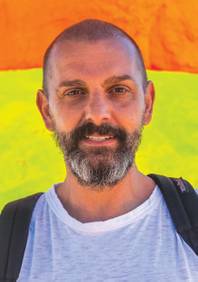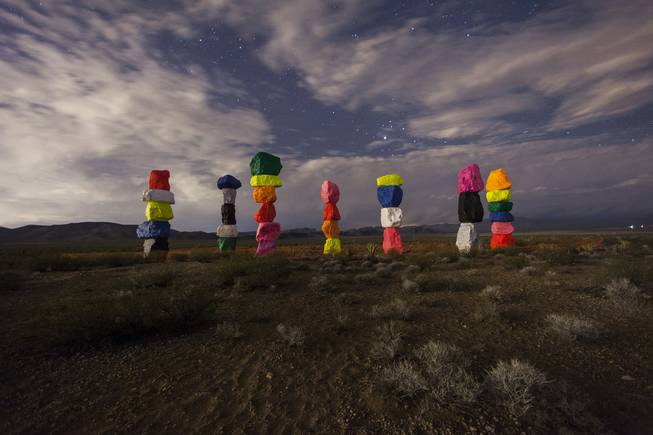Monday, May 16, 2016 | 2 a.m.
IF YOU GO
• Directions from Las Vegas: Take I-15 South to the Sloan Road exit, head east to Las Vegas Boulevard and drive north 7 miles.
• Directions from LA: Take 1-15 North to the Jean exit, head east to Las Vegas Boulevard and drive north 5 miles.
How were they made?
Las Vegas Paving Corp. worked with the artist on fabrication and installation — quarrying, cutting and sculpting the 33 rocks to specified sizes and shapes, hauling them to the site, drilling and stacking them on metal poles. Shaping them and making them stackable involved cutting them with diamond-tipped saws and using chisels, grinders and jackhammers. A subgrade made of concrete and reinforced steel sits underneath the ground — otherwise, the totems would partially sink under their own weight. The boulders weigh an average of 40,000 pounds each.

Ugo Rondinone
Who is responsible for the piece?
The installation was co-produced by Nevada Museum of Art in Reno and New York City’s Art Production Fund, a nonprofit organization working with other agencies to commission and produce public art to assist artists and reach broader audiences. Founded in 2000 by Yvonne Force Villareal and Doreen Remen, its projects include installations across New York, “Prada Marfa” in West Texas — a re-creation of a Prada apparel store in the desert along U.S. Highway 90 — and a partnership with the Cosmopolitan of Las Vegas on the Strip, resulting in the five-year run of the P3Studio artist residency and digital works installed throughout the hotel and on its marquee.
How long will it exist?
In 2018, all traces of the project, including the parking spaces and interpretive sign, will be removed. One totem will live on in Las Vegas, owned by MGM Resorts International and installed at its Park on the Strip.
How did they get permission to do it here?
To bring the project to life, organizers worked with local, federal and state officials to obtain permits from Clark County and the Bureau of Land Management. A law firm and Fairchild Consulting Group helped organizers navigate the permitting process.
Exhibiting reverence for the story of Las Vegas, the beauty of the vast Western landscape and its ancient geological presence, “Seven Magic Mountains” arrived blazing brighter than an electric rainbow and with a name akin to an amusement-park ride, resonating wildly with those pulling off of Interstate 15 for a closer look.
Cleverly critiquing Las Vegas-style simulacra 10 miles outside the city near Jean Dry Lake, the art installation is nearly five years in the making, with producers and others involved in the project navigating miles of red tape to finally debut it this month. The primitive totems of stacked boulders covered in Day-Glo paint hit like a hallucination, because in what world does a Bedrock-style contemporary monument just pop up in the desert?
Quick answer: the 21st-century world of land-based art. Co-produced by Reno’s Nevada Museum of Art and New York City’s Art Production Fund, Ugo Rondinone’s “Seven Magic Mountains” carries on the tradition of monumental works placed in the landscape, made from natural materials. The site-specific installation exists in the way that Las Vegas does: real and not real, magical and disarming, to some an eyesore, to others a profound statement speaking as vividly in daylight as at dusk.
“It’s celebrating a kind of legacy of the emergence of this city of light that grew out of a vast, empty landscape, a kind of new frontierism,” says David Walker, executive director and CEO of Nevada Museum of Art. Walker, who’s been involved in the project since its inception, adds of Rondinone: “He’s reminded us of this built environment.”
The installation will stand for two years, and the Northern museum will partner with Southern Nevada entities such as Clark County schools to wring out educational opportunities. At the end of its run, everything, including the parking spaces, will be removed. The only trace will be a single totem slated to join the considerable fine-art collection of MGM Resorts International, the project’s biggest donor, which put $1 million toward the $3.5 million vision.
Until then, countless eyes, whether it’s travelers detouring from the freeway or locals making pilgrimages from the city, will drink in the visual marvel.
“When I visited Las Vegas for the first time in 2012, I came out here and was surprised that in 15 minutes you’re in the complete desert,” says Rondinone, who was onsite for the work’s official unveiling earlier last week. “What’s fascinating about the desert is the silence. You’re liberated.”
But within that silence lives a very boisterous and colorful city of entertainment, a duality of natural and fabricated: “Not painted, you feel the age of the rock. Here you cannot see what’s under. It covers the honesty of the material,” the artist says. “Without Las Vegas, this work wouldn’t exist.”
Stonework is in the DNA of Rondinone, a Swiss-born, New York-based artist of Italian descent, whose ancestors hail from Matera, home to ancient cave dwellings. In 2013, his public-art installation “Human Nature” filled Rockefeller Center with stone figures weighing as much as 30,000 pounds and standing up to 20 feet tall.
“One of the things that’s sort of inherent in the project and in the continuum of land art is that we have a natural affinity toward these materials,” Walker says. “And I think when we see them on this scale manipulated by man, we’re kind of awestruck, and it impacts us probably in a more visceral way than experiencing a 4-by-5-foot oil painting in a museum.”
Michael Heizer’s 'City'
Since 1972, Michael Heizer has been creating one of the largest works of land art in history, a complex of minimalist, abstract structures more than a mile long, designed to last millennia and reference ancient monuments, modern urban infrastructure and the surrounding mountainous landscape.
On private land in Lincoln County — so perfectly placed within the stark landscape that those who’ve been able to see it say it’s only visible when approached — “City” is a story of perseverance, a project the Los Angeles County Museum of Art has called Heizer’s magnum opus.
At one point, “City” was threatened by the potential installation of rail lines to transport nuclear waste to Yucca Mountain, an effort that was defeated by lawmakers. And nearing completion after four decades, the work inspired a push to protect it and the pristine landscape and ancient petroglyphs surrounding it. As a result, President Obama designated more than 700,000 acres of the area as the Basin and Range National Monument. That designation came in August 2015 after a strong local and national effort involving politicians, educators, museum representatives, the Conservation Lands Foundation and local groups including the Contemporary Arts Center.
Michael Govan, director of the Los Angeles County Museum of Art, refers to “City” as one of the greatest artworks of our time, saying its importance extends beyond art history to history in general. It demands to be experienced, this testament to civilization isolated in the desert. But it will remain sealed off from the public until completion, guarded by the artist alone.
Double Negative
In 1969, after completing “Rift 1,” an abstract line depression in Jean Dry Lake, Michael Heizer set his sights on a much larger project: blasting more than 200,000 tons of rhyolite and sandstone from the ground to create 50-foot-deep trenches in the Mormon Mesa. He called the outdoor sculpture “Double Negative.”
Measuring 1,500 feet long, the two 30-foot-wide canyons slicing into the landscape about 80 miles northeast of Las Vegas comprise one of the largest sculptures in the world, owned by the Museum of Contemporary Art in Los Angeles. Heizer, a pioneer of the land-art movement, “chose that particular area because he liked the contour of the land,” says Bryant Robison, who lives nearby and was contracted to move the earth. The work has gained international attention over the decades, and travelers continue to seek it out, using GPS.
Art critic and former Las Vegas resident Dave Hickey once said, “It’s a sophisticated and intellectual idea based on the idea that in the West, positive and negative space is reversed. Instead of extending the earth up, he extended the sky down. It’s what I consider to be the best solution for outdoor sculpture in the West, because you can’t beat the sky.”
A guide to land art in Nevada and beyond
• SPIRAL JETTY. Using black basalt, salt crystals, water and earth, Robert Smithson left his mark on the Great Salt Lake’s Rozel Point with this 15-foot-wide coil. A bona fide landmark in Utah, its relationship with the environment and the seasons is part of its impact.
Finished: 1970
See it: Open to the public, about eight hours from Las Vegas on the I-15 North, past Salt Lake City.
• NEVADA MUSEUM OF ART. With a permanent collection that includes contemporary art by regional, national and international artists, rotating exhibits and the Altered Landscape Photography Collection, the Reno museum also commissions works and is home to the Center for Art + Environment, which is a research hub and archive for land art.
Opened: 1931
See it: Open to the public, 160 W. Liberty St., Downtown Reno (http://www.nevadaart.org).
• CITY. Begun by Michael Heizer decades ago, the complex of minimalist, abstract structures made of earth covers more than a mile and is designed to last millennia. Few have seen it in person, as the site is on private land and the artist is not yet finished with the project.
Started: 1972
See it: Google. (Seriously.)
• DOUBLE NEGATIVE. Cut into the Mormon Mesa — displacing 240,000 tons of rock — Michael Heizer’s trenches are 30 feet wide and 50 feet deep. The work exemplifies the land-art movement, which challenges traditional ideas of how art exists and how it affects those experiencing it.
Finished: 1970
See it: Open to the public, less than two hours from Las Vegas on Interstate 15 North to Moapa Valley. Detailed directions are available at moca.org.
• RODEN CRATER. Under construction in Northern Arizona’s Painted Desert, this unprecedented work by James Turrell is inside the crater of an inactive volcano. His purpose is to build a “controlled environment for the experiencing and contemplation of light.”
Started: 1977
See it: Last spring, a fundraiser for the work invited patrons to pay $6,500 for an exclusive tour, so you might want to sit tight.
JEAN DRY LAKE. Artists seem drawn to the dry lakebed, where in 1968 Michael Heizer dug a zigzag trench called “Rift 1” into the surface, one of nine depressions he made in dry lakes throughout Nevada to create a 520-mile earthwork. Eight years before, the Swiss artist Jean Tinguely had assembled sculptures from landfill materials and exploded them on the dirt surface in a literally groundbreaking work he called “Study for an End of the World No. 2.”
See it: Google again. No evidence that either work remains on the landscape.




Join the Discussion:
Check this out for a full explanation of our conversion to the LiveFyre commenting system and instructions on how to sign up for an account.
Full comments policy